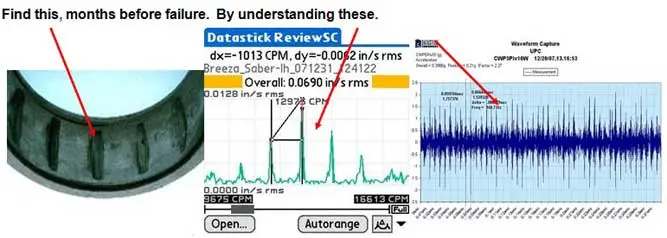SERVICES
Vibration Analysis Services by Failure Prevention Associates
Services
- Monthly Contracts for Vibration Routes.
- Weekly Critical Vibration Routes.
- Vibration analysis troubleshooting for repeated bad actors or tripping on high vibration alarms.
- Newly installed Rotating equipment commissioning – ensure your new assets will operate as expected.
Why is vibration analysis used?
Vibration analysis is a technique that is used to detect faults in machinery. The vibration of the machinery is measured and analyzed to identify any issues that may be present. This type of analysis can be used to detect problems such as imbalances, misalignment, and bearing faults.
How can vibration analysis help?
Vibration analysis can help to improve the reliability of machinery, and critical equipment by identifying problems early on. This allows for corrective action to be taken before the problem becomes more severe and causes downtime or damage to the equipment. vibration analysis can also help to improve the efficiency of machinery by reducing vibration levels. This can lead to reduced energy consumption and increased productivity.
What Can Vibration Analysis Detect?
Vibration analysis can be used to detect a wide range of problems, including:
- Imbalance
- Misalignment
- Bearing faults
- Gear faults
- Motor faults
- Pump faults
- Compressor faults


What is vibration data analysis in condition monitoring?
In condition monitoring predictive maintenance programs, vibration monitoring is often used as one of the tools for detecting faults in machinery. vibration analysis can be used to identify a wide range of problems, such as imbalances, misalignment, and bearing faults. vibration analysis is typically performed on a monthly or quarterly basis, depending on the machinery and operating conditions.
Vibration analysis can even be performed using a smartphone to slow down or speed up the recording to make analysis easier. This makes vibration analysis more accessible and can help reduce the cost of condition monitoring programs by eliminating travel time and staffing costs. Our remote vibration analysis will allow our experts to evaluate your critical assets remotely.
Vibration analysis Techniques – introduction to techniques and equipment
Vibration analysis is typically performed using vibration sensors that are mounted on the machinery. The vibration data is then collected and analyzed to identify any problems that may be present. Vibration analysis can even be performed using a smartphone to slow down or speed up the recording to make analysis easier.
There are many different types of vibration analysis equipment that can be used, depending on the type of machinery and the operating conditions. Some of the most common types of vibration analysis equipment include:
- Accelerometers
- Vibration analyzers
- Velocity transducers
- Displacement probes
- Laser vibrometers
Vibration analysis is an important tool that can be used to improve the reliability of machinery by identifying problems early on. This allows for corrective action to be taken before the problem becomes more severe and causes downtime or damage to the equipment. vibration analysis can also help to improve the efficiency of machinery by reducing vibration levels. This can lead to reduced energy consumption and increased productivity.
What are the Types of Vibration?
There are two types of vibration signals: free and forced. Free vibration is when an object vibrates on its own, without any outside forces acting on it. Forced vibration is when an outside force is applied to an object, causing it to vibrate.
The three main types of vibration are:
- Linear vibration
- Angular vibration
- Rotational vibration
Linear vibration is when an object vibrates in a straight line. Angular vibration is when an object vibrates around a central point. Rotational vibration is when an object vibrates around an axis.
How Vibration Signals are measured
There are many ways to measure vibration, depending on the type of vibration and the equipment that is being used. Trained vibration analysts will use the following techniques and tools to assess vibration patterns and spectral analysis to evaluate machinery vibrations.
Accelerometer analysis tools are typically used to measure linear vibration, while velocity transducers are typically used to measure angular vibration. Displacement probes are typically used to measure rotational vibration. Laser vibrometers can be used to measure all three types of vibration.
When analyzing vibration frequencies, it is important to consider the vibration frequency spectrum. The vibration spectrum analysis is a plot of the vibration amplitude ( intensity ) vs. frequency. The vibration amplitude is the amount of displacement that an object undergoes during vibration. The frequency range is the number of times that an object vibrates per second.
The vibration spectrum can be used to identify the type of vibration that is present. It can also be used to identify the natural frequency of vibration for a particular object. The natural frequency is the frequency at which an object vibrates when it is not being acted on by any outside forces.
What is the Difference Between Vibration Analysis and Condition Monitoring?
Vibration analysis is a type of condition monitoring that is used to detect faults in machinery. Condition monitoring is a preventive maintenance strategy that is used to monitor the condition of machinery and equipment over time.
While vibration analysis can be used as part of a condition monitoring program, it is not the only tool that is used.
Vibration Spectrum Analysis identifies your rotating equipment problems before they fail.
Vibration Spectrum Analysis identifies bearing failures and a significant amount of other rotating equipment problems before they become disasters. It is the best practice for monitoring rotating machinery (cooling towers, gearboxes, pumps, electric motors, blowers, turbines, etc.). Vibration Analysis is also important for acceptance testing of new equipment installations (building floors, piping, rotating equipment).
The vibration analysis process can identify and locate problems before you can see, feel, or hear them coming. Vibration data collection can even be completed remotely to gather data and monitor machine health continuously.
Our vibration services can be done quickly and efficiently to make sure that your machines are running correctly. Failure Prevention Associates can also optimize your machine performance through vibration analysis and its other services.
Process Safety Management
Compliance issues are at the top of everyone’s mind. Not only is it good practice for the machines, but also to ensure the health and safety of staff.
You want your machines running at top performance and efficiency.
Being compliant means avoiding unplanned failures. You should be working on continually improving your efficiencies and assets. Failure Prevention Associates helps you do achieve those goals.


